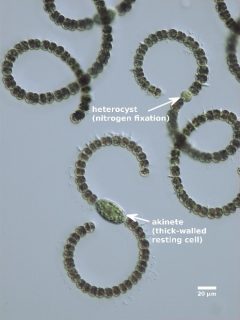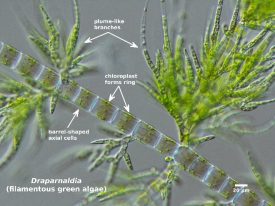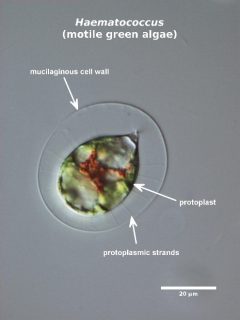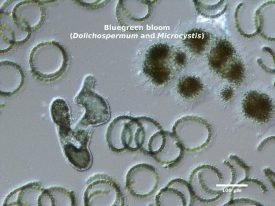by Dr. Robin Matthews
Director, Institute for Watershed Studies
Huxley College of the Environment
Western Washington University
 To help make algal identification more accessible to students in my Freshwater Algae class, I am writing a series of taxonomic guides to algae in Northwest Washington. I recently posted the first two volumes of these guides, Volume I. Cyanobacteria (cedar.wwu.edu/cedarbooks/6/) and Volume II. Chlorophyta and Rhodophyta (cedar.wwu.edu/cedarbooks/1/). Both volumes are formatted as E-books, with active links that allow the user to move easily between the keys, figures, and sections. The keys are relatively simple, with minimal use of technical jargon, and contain annotated images that show the relevant taxonomic features.
To help make algal identification more accessible to students in my Freshwater Algae class, I am writing a series of taxonomic guides to algae in Northwest Washington. I recently posted the first two volumes of these guides, Volume I. Cyanobacteria (cedar.wwu.edu/cedarbooks/6/) and Volume II. Chlorophyta and Rhodophyta (cedar.wwu.edu/cedarbooks/1/). Both volumes are formatted as E-books, with active links that allow the user to move easily between the keys, figures, and sections. The keys are relatively simple, with minimal use of technical jargon, and contain annotated images that show the relevant taxonomic features.
 I have had a life-long fascination with the microscopic world in freshwater lakes and streams. As a child I loved to collect samples from the local “ditch” to look at using my student microscope (best birthday present ever!). I took my first algae class in 1973 from Gerry Prescott, and it changed my life. What I have learned in over fifty years of study is that the microscopic world contains an astonishing ecological complexity. There are tiny green plant-like algae, predators that consume any living organism they can engulf, parasitic fungi that invade living algae cells, viruses that infect algae, and free-loading, tag-along microorganisms that lodge in the slimy mucilage surrounding algae. These communities are as complex and interesting as the forests, deserts, and jungles we see around us.
I have had a life-long fascination with the microscopic world in freshwater lakes and streams. As a child I loved to collect samples from the local “ditch” to look at using my student microscope (best birthday present ever!). I took my first algae class in 1973 from Gerry Prescott, and it changed my life. What I have learned in over fifty years of study is that the microscopic world contains an astonishing ecological complexity. There are tiny green plant-like algae, predators that consume any living organism they can engulf, parasitic fungi that invade living algae cells, viruses that infect algae, and free-loading, tag-along microorganisms that lodge in the slimy mucilage surrounding algae. These communities are as complex and interesting as the forests, deserts, and jungles we see around us.
 One of my goals as an educator has been to introduce students to the amazing world of freshwater algae. This is a daunting task, given that in any particular lake on a warm summer day, I can find more than fifty different kinds of algae. And in the same lake a few weeks later, I can often find fifty new ones. To make matters worse, algal taxonomy is undergoing massive changes due to the addition of genetic analysis, which often shows that algae that look the same are not even remotely related genetically. To most non-taxonomists, including citizen scientists and lake managers, scientists’ inability to settle on a name for common types of algae is aggravating. And for students who are just starting to learn algal taxonomy, the confusion over names is one more obstacle to learning. I hope these books can help bring some measure of order to this chaos, and make the whole field more accessible to the newcomer as well as the professional.
One of my goals as an educator has been to introduce students to the amazing world of freshwater algae. This is a daunting task, given that in any particular lake on a warm summer day, I can find more than fifty different kinds of algae. And in the same lake a few weeks later, I can often find fifty new ones. To make matters worse, algal taxonomy is undergoing massive changes due to the addition of genetic analysis, which often shows that algae that look the same are not even remotely related genetically. To most non-taxonomists, including citizen scientists and lake managers, scientists’ inability to settle on a name for common types of algae is aggravating. And for students who are just starting to learn algal taxonomy, the confusion over names is one more obstacle to learning. I hope these books can help bring some measure of order to this chaos, and make the whole field more accessible to the newcomer as well as the professional.
 Interest in freshwater algae is also driven by practical considerations. For example, there is increasing awareness of the potentially harmful effects of algae blooms. Many communities have experienced lake closures caused by high concentrations of toxins produced by blue-green algae (Cyanobacteria). Scientific studies of lake sediment cores suggest that our perceptions are correct: more lakes are forming blue-green blooms, and the blooms within specific lakes are not only occurring more frequently but persisting for longer periods during the year (Taranu et al., 2015). In reality, most types of algae are not harmful, and instead play a hugely important role in lake ecosystems, and I hope these books can help shed light on the differences.
Interest in freshwater algae is also driven by practical considerations. For example, there is increasing awareness of the potentially harmful effects of algae blooms. Many communities have experienced lake closures caused by high concentrations of toxins produced by blue-green algae (Cyanobacteria). Scientific studies of lake sediment cores suggest that our perceptions are correct: more lakes are forming blue-green blooms, and the blooms within specific lakes are not only occurring more frequently but persisting for longer periods during the year (Taranu et al., 2015). In reality, most types of algae are not harmful, and instead play a hugely important role in lake ecosystems, and I hope these books can help shed light on the differences.
Literature Cited
Taranu, Z. E., I. Gregory-Eaves, P. R. Leavitt, L. Bunting, T. Buchaca, J. Catalan, I. Domaizon, P. Guilizzoni, A. Lami, S. McGowan, H. Moorhouse, G. Morabito, F. R. Pick, M. A. Stevenson, P. L. Thompson, R. D. Vinebrooke. 2015. Acceleration of cyanobacterial dominance in north temperate-subarctic lakes during the Anthropocene. Ecology Letters, Volume 18(4): 375–384.









